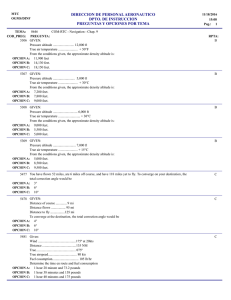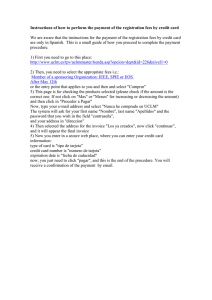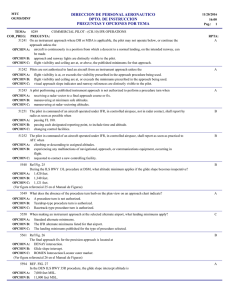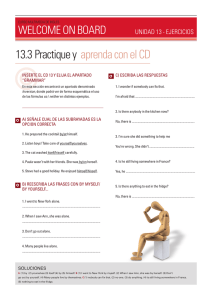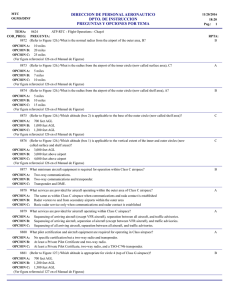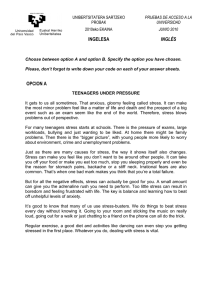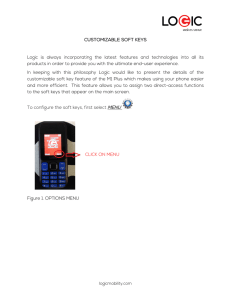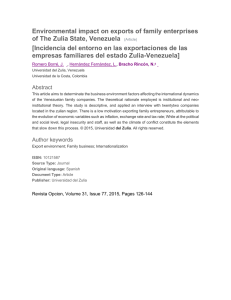ATP-RTC - Performance
Anuncio
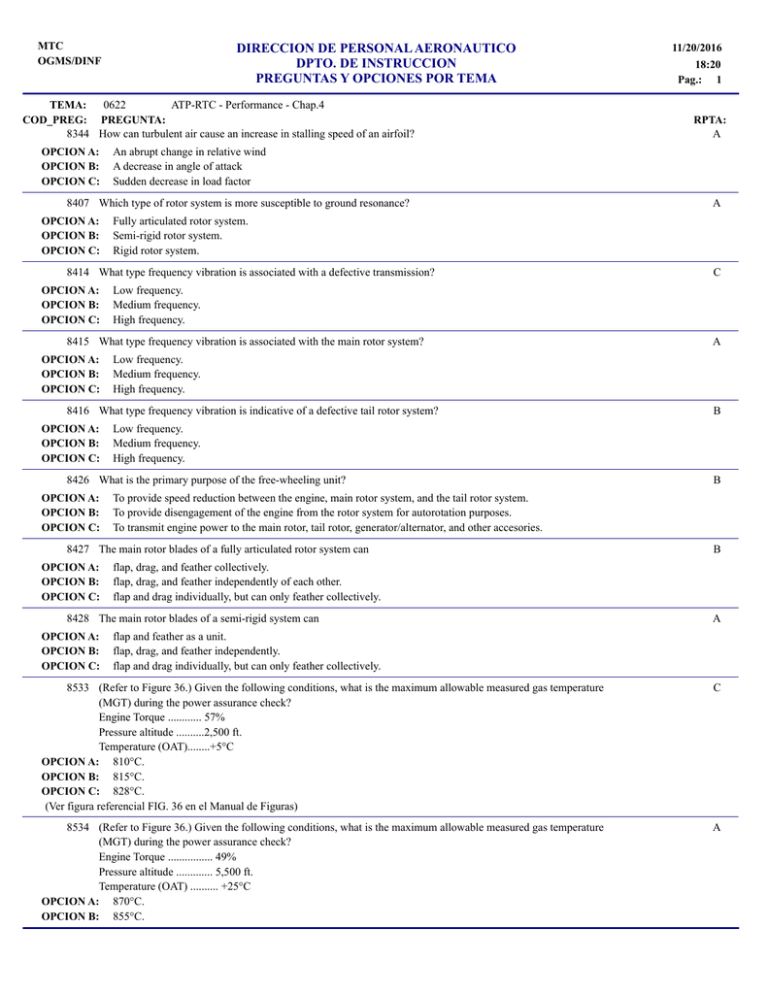
MTC OGMS/DINF DIRECCION DE PERSONAL AERONAUTICO DPTO. DE INSTRUCCION PREGUNTAS Y OPCIONES POR TEMA TEMA: 0622 ATP-RTC - Performance - Chap.4 COD_PREG: PREGUNTA: 8344 How can turbulent air cause an increase in stalling speed of an airfoil? OPCION A: OPCION B: OPCION C: B B flap, drag, and feather collectively. flap, drag, and feather independently of each other. flap and drag individually, but can only feather collectively. 8428 The main rotor blades of a semi-rigid system can OPCION A: OPCION B: OPCION C: B To provide speed reduction between the engine, main rotor system, and the tail rotor system. To provide disengagement of the engine from the rotor system for autorotation purposes. To transmit engine power to the main rotor, tail rotor, generator/alternator, and other accesories. 8427 The main rotor blades of a fully articulated rotor system can OPCION A: OPCION B: OPCION C: A Low frequency. Medium frequency. High frequency. 8426 What is the primary purpose of the free-wheeling unit? OPCION A: OPCION B: OPCION C: C Low frequency. Medium frequency. High frequency. 8416 What type frequency vibration is indicative of a defective tail rotor system? OPCION A: OPCION B: OPCION C: A Low frequency. Medium frequency. High frequency. 8415 What type frequency vibration is associated with the main rotor system? OPCION A: OPCION B: OPCION C: RPTA: A Fully articulated rotor system. Semi-rigid rotor system. Rigid rotor system. 8414 What type frequency vibration is associated with a defective transmission? OPCION A: OPCION B: OPCION C: 18:20 Pag.: 1 An abrupt change in relative wind A decrease in angle of attack Sudden decrease in load factor 8407 Which type of rotor system is more susceptible to ground resonance? OPCION A: OPCION B: OPCION C: 11/20/2016 A flap and feather as a unit. flap, drag, and feather independently. flap and drag individually, but can only feather collectively. 8533 (Refer to Figure 36.) Given the following conditions, what is the maximum allowable measured gas temperature (MGT) during the power assurance check? Engine Torque ............ 57% Pressure altitude ..........2,500 ft. Temperature (OAT)........+5°C OPCION A: 810°C. OPCION B: 815°C. OPCION C: 828°C. (Ver figura referencial FIG. 36 en el Manual de Figuras) C 8534 (Refer to Figure 36.) Given the following conditions, what is the maximum allowable measured gas temperature (MGT) during the power assurance check? Engine Torque ................ 49% Pressure altitude ............. 5,500 ft. Temperature (OAT) .......... +25°C OPCION A: 870°C. OPCION B: 855°C. A MTC OGMS/DINF DIRECCION DE PERSONAL AERONAUTICO DPTO. DE INSTRUCCION PREGUNTAS Y OPCIONES POR TEMA 11/20/2016 18:20 Pag.: 2 OPCION C: 880°C. (Ver figura referencial FIG. 36 en el Manual de Figuras) 8535 (Refer to Figure 36.) Given the following conditions, what is the maximum allowable measured gas temperature (MGT) during the power assurance check? Engine torque ................ 54% Pressure altitude ............ 500 ft. Temperature (OAT) ......... +25°C OPCION A: 840°C. OPCION B: 830°C. OPCION C: 820°C. (Ver figura referencial FIG. 36 en el Manual de Figuras) A 8536 (Refer to Figure 36.) Given the following conditions, what is the maximum allowable measured gas temperature (MGT) during the power assurance check? Engine torque ................... 43% Pressure altitude ............... 9,000 ft. Temperature (OAT) ............ -15°C OPCION A: 782°C. OPCION B: 768°C. OPCION C: 750°C. (Ver figura referencial FIG. 36 en el Manual de Figuras) B 8537 (Refer to Figure 36.) Given the following conditions, what is the maximum allowable meassured gas temperature (MGT) during the power assurance check? Engine torque ............. 52% Pressure altitude ......... 1,500 ft. Temperature (OAT) ...... +35°C OPCION A: 880°C. OPCION B: 865°C. OPCION C: 872°C. (Ver figura referencial FIG. 36 en el Manual de Figuras) B 8538 (Refer to Figure 37.) What is the maximum gross weight for hovering in ground effect at 3,000' preesure altitude and +25°C? OPCION A: 17,300 pounds. OPCION B: 14,700 pounds. OPCION C: 16,600 pounds. (Ver figura referencial FIG. 37 en el Manual de Figuras) A 8539 (Refer to Figure 37.) What is the maximum gross weight for hovering in ground effect at 6,000' preesure altitude and +15°C? OPCION A: 17,200 pounds. OPCION B: 16,600 pounds. OPCION C: 14,200 pounds. (Ver figura referencial FIG. 37 en el Manual de Figuras) B 8540 (Refer to Figure 37.) What is the maximum gross weight for hovering in ground effect at 7,000' pressure altitude and +35°C? OPCION A: 13,500 pounds. OPCION B: 14,700 pounds. OPCION C: 12,100 pounds. (Ver figura referencial FIG. 37 en el Manual de Figuras) A 8541 (Refer to Figure 37.) What is the maximum gross weight for hovering in ground effect at 4,500' pressure altitude and +20°C? OPCION A: 14,500 pounds. OPCION B: 16,500 pounds. OPCION C: 17,000 pounds. (Ver figura referencial FIG. 37 en el Manual de Figuras) C MTC OGMS/DINF DIRECCION DE PERSONAL AERONAUTICO DPTO. DE INSTRUCCION PREGUNTAS Y OPCIONES POR TEMA 11/20/2016 18:20 Pag.: 3 8542 (Refer to Figure 37) What is the maximum gross weight for hovering in ground effect at 2,500' pressure altitude and 35°C? OPCION A: 16,200 pounds. OPCION B: 16,600 pounds. OPCION C: 14,600 pounds. (Ver figura referencial FIG. 37 en el Manual de Figuras) A 8543 (Refer to Figure 38.) What is the maximum gross weight for hovering out of ground effect at 3,000' pressure altitude and +30°C? OPCION A: 17,500 pounds. OPCION B: 14,300 pounds. OPCION C: 13,400 pounds. (Ver figura referencial FIG. 38 en el Manual de Figuras) B 8544 (Refer to Figure 38.) What is the maximum gross weight for hovering out of ground effect at 6,000' pressure altitude and +15°C? OPCION A: 16,800 pounds. OPCION B: 13,500 pounds. OPCION C: 14,400 pounds. (Ver figura referencial FIG. 38 en el Manual de Figuras) C 8545 (Refer to Figure 38.) What is the maximum gross weight for hovering out of ground effect at 7,000' pressure altitude and +35°C? OPCION A: 14,000 pounds. OPCION B: 11,600 pounds. OPCION C: 12,500 pounds. (Ver figura referencial FIG. 38 en el Manual de Figuras) B 8546 (Refer to Figure 38.) What is the maximum gross weight for hovering out of ground effect at 4,500' pressure altitude and 20°C? OPCION A: 14,500 pounds. OPCION B: 14,000 pounds. OPCION C: 17,000 pounds. (Ver figura referencial FIG. 38 en el Manual de Figuras) A 8547 (Refer to Figure 38.) What is the maximum gross weight for hovering out of ground effect at 2,500' pressure altitude and +30°C? OPCION A: 17,400 pounds. OPCION B: 15,000 pounds. OPCION C: 14,500 pounds. (Ver figura referencial FIG. 38 en el Manual de Figuras) C 8548 (Refer to Figure 39.) What is the takeoff distance over a 50-foot obstacle? Pressure altitude ......... 3,500 ft Temperature (OAT) ......+20°C Gross weight ............... 15,000 lb. OPCION A: 1,070 feet. OPCION B: 1,020 feet. OPCION C: 1,100 feet. (Ver figura referencial FIG. 39 en el Manual de Figuras) A 8549 (Refer to Figure 39.) What is the takeoff distance over a 50-foot obstacle? Pressure altitude .......... 5,000 ft. Temperature (OAT) ....... -10°C Gross weight ................ 11,000 lb. OPCION A: 1,000 feet. OPCION B: 920 feet. OPCION C: 870 feet. (Ver figura referencial FIG. 39 en el Manual de Figuras) C MTC OGMS/DINF DIRECCION DE PERSONAL AERONAUTICO DPTO. DE INSTRUCCION PREGUNTAS Y OPCIONES POR TEMA 11/20/2016 18:20 Pag.: 4 8550 (Refer to Figure 39.) What is the takeoff distance over a 50-foot obstacle? Pressure altitude .......... 6,500 ft. Temperature (OAT) ....... 0°C Gross weight ................ 13,500 lb. OPCION A: 1,500 feet. OPCION B: 1,050 feet. OPCION C: 1,100 feet. (Ver figura referencial FIG. 39 en el Manual de Figuras) B 8551 (Refer to Figure 39.) What is the takeoff distance over a 50-foot obstacle? Pressure altitude ............. 9,000 ft. Temperature (OAT) .......... +20°C Gross weight ................... 15,000 lb. OPCION A: 1,300 feet. OPCION B: 1,350 feet. OPCION C: 1,250 feet. (Ver figura referencial FIG. 39 en el Manual de Figuras) B 8552 (Refer to Figure 39.) What is the takeoff distance over a 50-foot obstacle? Pressure altitude ........... -1,000 ft. Temperature (OAT)......... +25°C Gross weight .................. 14,000 lb. OPCION A: 1,000 feet. OPCION B: 900 feet. OPCION C: 950 feet. (Ver figura referencial FIG. 39 en el Manual de Figuras) B 8553 (Refer to Figure 40.) What is the climb performance with both engines operating? Pressure altitude 9,500 ft Temperature (OAT) -5°C Heater ON OPCION A: 925 ft/min OPCION B: 600 ft/min OPCION C: 335 ft/min B 8554 (Refer to Figure 40.) What is the climb performance with both engines operating? Pressure altitude 7,500 ft Temperature +5° C Heater ON OPCION A: 905 ft/min OPCION B: 765 ft/min OPCION C: 1,080 ft/min B 8555 (Refer to Figure 40.) What is the climb performance with both engines operating? Pressure altitude ............. 6,500 ft. Temperature (OAT) .......... +25°C Heater .......................... OFF OPCION A: 285 ft/min OPCION B: 600 ft/min OPCION C: 400 ft/min B 8556 (Refer to Figure 40.) What is the climb performance with both engines operating? Pressure altitude ...................11,500 ft Temperature (OAT).................-15°C Heater .................................. ON OPCION A: 645 ft/min OPCION B: 375 ft/min OPCION C: 330 ft/min B MTC OGMS/DINF DIRECCION DE PERSONAL AERONAUTICO DPTO. DE INSTRUCCION PREGUNTAS Y OPCIONES POR TEMA 11/20/2016 18:20 Pag.: 5 8557 (Refer to Figure 40.) What is the climb performance with both engines operating? Pressure altitude ...................3,500 ft Temperature (OAT).................-10°C Heater .................................. ON OPCION A: 985 ft/min OPCION B: 1,300 ft/min OPCION C: 1,360 ft/min A 8558 (Refer to Figure 41.) What is the single-engine climb or descent performance? Pressure altitude ...................7,500 ft Temperature (OAT).................-0°C OPCION A: 80 ft/min descent OPCION B: 10 ft/min climb OPCION C: 50 ft/min climb A 8559 (Refer to Figure 41.) Given the following, what is the single-engine climb or descent performance? Pressure altitude .................... 3,000 ft Temperature (OAT).................... +35°C OPCION A: 150 ft/min descent OPCION B: 350 ft/min climb OPCION C: 100 ft/min descent C 8560 (Refer to Figure 41.) Given the following, what is the single-engine climb or descent performance? Pressure altitude ....................................... 4,700 ft Temperature (OAT) .................................... +20°C OPCION A: 420 ft/min climb OPCION B: 60 ft/min climb OPCION C: 60 ft/min descent B 8561 (Refer to Figure 41.) Given the following, what is the single-engine climb or descent performance? Pressure altitude ....................................... 9,500 ft Temperature (OAT) .................................... -10°C OPCION A: 600 ft/min descent OPCION B: 840 ft/min descent OPCION C: 280 ft/min descent C 8562 (Refer to Figure 41.) Given the following, what is the single-engine climb or descent performance? Pressure altitude ....................................... 1,500 ft Temperature (OAT) .................................... +45°C OPCION A: 100 ft/min descent OPCION B: 360 ft/min climb OPCION C: 200 ft/min descent A 8563 (Refer to Figure 42.) Given the following, what is the airspeed (VNE)? Gross weight .................... 16,500 lb Pressure altitude ............... 5,000 ft Temperature (OAT) ............ -15°C OPCION A: 128 KIAS OPCION B: 133 KIAS OPCION C: 126 KIAS A 8564 (Refer to Figure 42.) Given the following, what is the airspeed (VNE)? Gross weight .................... 17,500 lb Pressure altitude ............... 4,000 ft Temperature (OAT) ............ +10°C OPCION A: 114 KIAS OPCION B: 120 KIAS OPCION C: 130 KIAS B MTC OGMS/DINF DIRECCION DE PERSONAL AERONAUTICO DPTO. DE INSTRUCCION PREGUNTAS Y OPCIONES POR TEMA 11/20/2016 18:20 Pag.: 6 8565 (Refer to Figure 42.) What is the airspeed limit (VNE)? Gross weight .................... 15,000 lb Pressure altitude ............... 6,000 ft Temperature (OAT) ............ +0°C OPCION A: 135 KIAS OPCION B: 127 KIAS OPCION C: 143 KIAS A 8566 (Refer to Figure 42.) What is the airspeed limit (VNE)? Gross weight .................... 14,000 lb Pressure altitude ............... 8,000 ft Temperature (OAT) ............ -15°C OPCION A: 121 KIAS OPCION B: 123 KIAS OPCION C: 113 KIAS A 8567 (Refer to Figure 42.) What is the airspeed limit (VNE)? Gross weight .................... 12,500 lb Pressure altitude ............... 14,000 ft Temperature (OAT) ............ -20°C OPCION A: 99 KIAS OPCION B: 108 KIAS OPCION C: 103 KIAS C 8568 (Refer to Figure 42.) What is the single-engine landing distance over a 50 foot obstacle? Gross weight .................... 12,500 lb Pressure altitude ............... 3,500 ft Temperature (OAT) ............ +30°C OPCION A: 850 feet OPCION B: 900 feet OPCION C: 1,000 feet C 8569 (Refer to Figure 43.) What is the single-engine landing distance over a 50-foot obstacle? Gross weight .................... 16,500 lb Pressure altitude ............... 5,500 ft Temperature (OAT) ............ -10°C OPCION A: 1,700 feet OPCION B: 1,550 feet OPCION C: 1,600 feet B 8570 (Refer to Figure 43.) What is the single-engine landing distance over a 50 foot obstacle? Gross weight .................... 15,000 lb Pressure altitude ............... 8,000 ft Temperature (OAT) ............ +20°C OPCION A: 1,900 feet OPCION B: 1,800 feet OPCION C: 2,000 feet A 8571 (Refer to Figure 43.) What is the single-engine landing distance over a 50 foot obstacle? Gross weight .................... 14,000 lb Pressure altitude ............... 1,000 ft Temperature (OAT) ............ +10°C OPCION A: 650 feet OPCION B: 920 feet OPCION C: 800 feet B MTC OGMS/DINF DIRECCION DE PERSONAL AERONAUTICO DPTO. DE INSTRUCCION PREGUNTAS Y OPCIONES POR TEMA 8572 (Refer to Figure 43.) What is the single-engine landing distance over a 50-foot obstacle? Gross weight .................... 17,000 lb Pressure altitude ............... 4,000 ft Temperature (OAT) ............ +40°C OPCION A: 1,850 feet OPCION B: 2,200 feet OPCION C: 2,000 feet 9058 Which place in the turbojet engine is subjected to the highest temperature? OPCION A: OPCION B: OPCION C: 9063 What effect, if any, does high ambient temperature have upon the thrust output of a turbine engine? A C A C Intermittent "backfire" stall Transient "backfire" stall Steady, continuous flow reversal stall 9067 What recovery would be appropriate in the event of compressor stall? OPCION A: OPCION B: OPCION C: A Strong vibrations and loud roar Occasional loud "bang" and flow reversal Complete loss of power with severe reduction in airspeed 9066 Which type of compressor stall has the greatest potential for severe engine damage? OPCION A: OPCION B: OPCION C: C Loud, steady roar accompanied by heavy shud-dering Sudden loss of thrust accompanied by a loud whine Intermittent "bang", as backfires and flow reversals take place 9065 What indicates that a compressor stall has developed and become steady? OPCION A: OPCION B: OPCION C: B Thrust will be reduced due to the decrease in air density Thrust will remain the same, but turbine temperature will be higher Thrust will be higher because more heat energy is extracted from the hotter air 9064 What characterizes a translent compressor stall? OPCION A: OPCION B: OPCION C: C increase due to greater efficiency of jet aircraft in thin air remain the same since compression of inlet air will compensate for any decrease in air pressure decrease due to higher density altitude 9062 What effect will an increase in altitude have upon the available equivalent shaft horsepower (ESHP) of a turboprop engine? OPCION A: Lower air density anda engine mass flow will cause a decrease in power OPCION B: Higher propeller efficiency will cause an increase in usable power (ESHP) and thrust OPCION C: Power will remain the same but propeller efficiency will decrease OPCION A: OPCION B: OPCION C: C limiting compressor speed limiting exhaust gas temperature limiting torque 9061 An outside air pressure decreases, thrust output will OPCION A: OPCION B: OPCION C: C As air density decreases, thrust increases As temperature increases, thrust increases As temperature increases, thrust decreases 9060 The most important restriction to the operation of turbojec or turboprop engines is OPCION A: OPCION B: OPCION C: 18:20 Pag.: 7 Compressor discharge Fuel spray nozzles Turbine inlet 9059 What effect would a change in ambient temperature or air density have on gas-turbine-engine performance? OPCION A: OPCION B: OPCION C: 11/20/2016 Reduce fuel flow, reduce angle of attack, and increase airspeed Advance throttle, lower angle of attack, and reduce airspeed Reduce throttle, reduce airspeed, and increase angle of attack A MTC OGMS/DINF DIRECCION DE PERSONAL AERONAUTICO DPTO. DE INSTRUCCION PREGUNTAS Y OPCIONES POR TEMA 11/20/2016 18:20 Pag.: 8 9068 Under normal operating conditions, which combination of MAP and RPM produce the most severe wear, fatigue, and damage to high performance reciprocating engines? OPCION A: High RPM and low MAP OPCION B: Low RPM and high MAP OPCION C: High RPM and high MAP A 9069 What effect does high relative humidity have upon the maximum power output of modern aircraft engines? B OPCION A: OPCION B: OPCION C: Neither turbojet nor reciprocating engines are affected Reciprocating engines will experience a significant loss of BHP Turbojet engines will experience a significant loss of thrust 9071 Minimum specific fuel consumption of the turbo-prop engine is normally available in which altitude range? OPCION A: OPCION B: OPCION C: 10,000 feet to 25,000 feet 25,000 feet to the tropopause The tropopause to 45,000 feet 9129 If severe turbulence is encountered, which procedure is recommended? OPCION A: OPCION B: OPCION C: B Maintain a constant altitude Maintain a constant attitude Maintain constant airspeed and altitude 9321 Which is the correct symbol for design cruising speed? OPCION A: OPCION B: OPCION C: B Vc Vs Vma A
